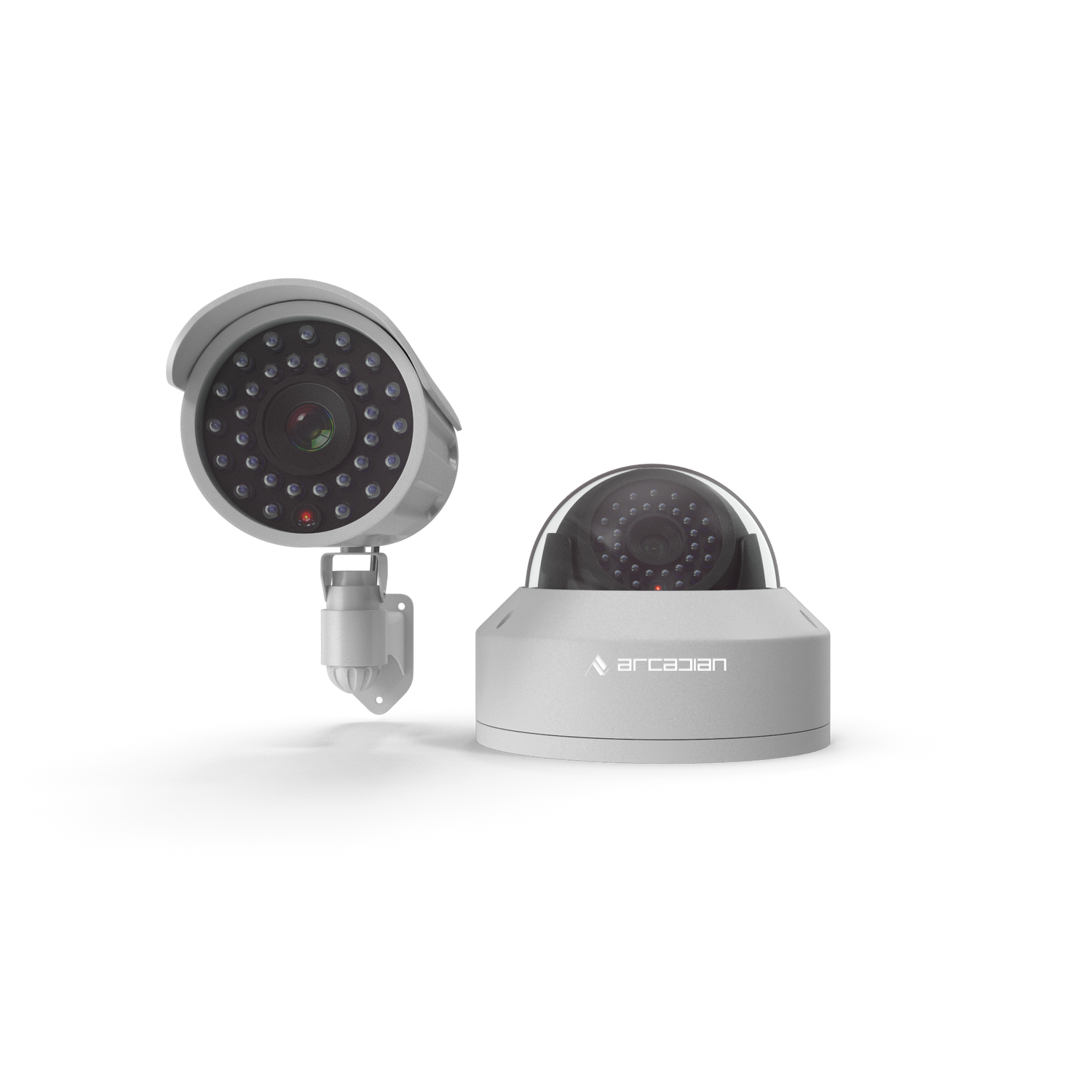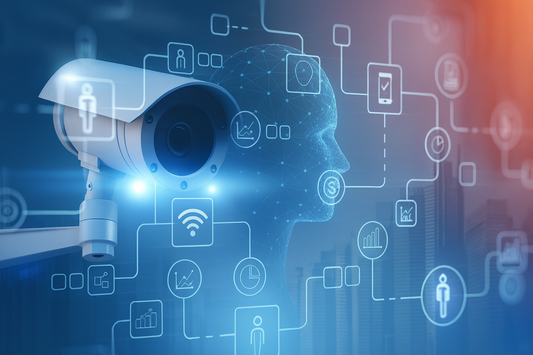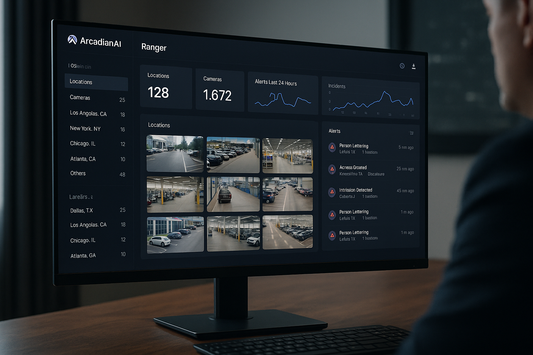How Real-Time Threat Detection Works in AI Surveillance Systems
Imagine if your security camera didn't just see — it understood. That's the promise of AI threat detection and real-time threat detection powered by artificial intelligence (AI). In today's world, where threats evolve faster than ever, traditional surveillance systems — with their passive recording and delayed human response — just...

- What Is AI Threat Detection and Real-Time Threat Detection?
- How AI Surveillance Systems Work: Step-by-Step Threat Detection Technology
- Why AI Threat Detection Beats Traditional Surveillance
- Real Impact: Numbers That Matter for AI Security Solutions
- The Tech Behind AI Threat Detection: AI Models & Infrastructure
- Cloud vs Edge: Where AI Threat Detection Lives
- Can AI Threat Detection Really "Understand" Human Behavior?
- Real-Time Alerts: How AI Security Solutions Keep Users Informed
- Who's Using AI Threat Detection Technology?
- AI Threat Detection vs "Video Analytics"
- Ethics, Privacy, and Compliance in AI Security Solutions
- Conclusion: Smarter, Safer, Faster AI Security Solutions
Imagine if your security camera didn't just see — it understood. That's the promise of AI threat detection and real-time threat detection powered by artificial intelligence (AI). In today's world, where threats evolve faster than ever, traditional surveillance systems — with their passive recording and delayed human response — just aren't enough.
But how does AI-driven threat detection actually work? What makes it different from motion detection or video analytics of the past? And more importantly, how can businesses use advanced threat detection with AI to boost safety, prevent incidents, and reduce costs?
Let's explore the inner workings of AI surveillance systems and their revolutionary ai threat detection capabilities through cutting-edge AI security solutions.
What Is AI Threat Detection and Real-Time Threat Detection?
AI threat detection in AI surveillance systems refers to the system's ability to analyze live video feeds as they happen, identify abnormal or dangerous behavior, and trigger alerts or actions within seconds — all without human intervention.
Unlike older systems that required someone to review footage or respond to basic motion triggers, AI based threat detection systems are trained to understand context through real-time video analysis. They evaluate human behavior, recognize potential threats like loitering, aggression, or weapons, and even learn patterns over time using advanced AI security software.
Modern threat detection technology combines artificial intelligence with real-time video analysis to create comprehensive AI security solutions that outperform traditional monitoring methods.
How AI Surveillance Systems Work: Step-by-Step Threat Detection Technology
Here's a simplified breakdown of how a modern AI surveillance system processes real-time video analysis to enable ai threat detection:
1. Video Ingestion
The AI security solutions capture live video streams from IP cameras — either from local setups or cloud-connected infrastructure managed by AI security companies.
2. Preprocessing and Frame Sampling
AI threat detection doesn't process every pixel of every frame. Instead, it intelligently samples and preprocesses the data to reduce load — filtering out irrelevant frames or low-confidence noise through advanced AI security software.
3. Object Detection with Real-Time Video Analysis
Using computer vision models like YOLOv5, Faster R-CNN, or proprietary networks from leading AI security companies, the system identifies and labels objects: people, vehicles, bags, weapons, etc.
4. Behavior Analysis Through AI-Driven Threat Detection
This is where ai threat detection starts to shine. It tracks movement, posture, interaction between people, and deviations from expected patterns using real-time video analysis. For instance:
- Is someone pacing in front of a storefront late at night?
- Is there a sudden crowd gathering in a quiet area?
- Has someone entered a restricted zone?
5. Contextual Understanding with Advanced Threat Detection with AI
Through deep learning models trained on thousands of real-world scenarios, AI based threat detection systems interpret context:
- A man running in a park? Normal.
- A man running inside a closed jewelry store at 3 AM? Threat.
6. Triggering Alerts Through AI Managed Security
Once ai threat detection identifies a potential threat, the system triggers real-time alerts:
- Notifications to staff or monitoring agents
- Audio/visual deterrents (e.g., sirens, flashing lights)
- Automated locking or response protocols
- Optional escalation to emergency services
- What Types of Threats Can AI Threat Detection Systems Detect in Real Time?
Modern AI surveillance systems with advanced threat detection with AI aren't limited to just motion or sound. Here's what they can catch through real-time video analysis — often in under a second:
- Aggressive behavior or fights
- Firearms or weapons detection
- Loitering or suspicious lingering
- Forced entries or vandalism
- Shoplifting or theft
- Slip and fall incidents
- Abandoned packages
- Vehicle violations (wrong direction, speeding)
In retail, for example, AI-driven threat detection can distinguish between a customer browsing and someone acting nervously or erratically — reducing shoplifting risks proactively through intelligent AI security solutions.
Why AI Threat Detection Beats Traditional Surveillance
Here's how ai threat detection changes the game compared to passive surveillance systems:
|
Feature |
Traditional CCTV |
AI Threat Detection Systems |
|
Detection Type |
Manual (human review) |
Automated AI threat detection |
|
Speed of Response |
Minutes to hours |
Seconds with real-time threat detection |
|
Human Dependency |
High |
Low (AI managed security) |
|
Scalability |
Limited by staff |
Scales with AI security solutions |
|
Context Awareness |
None |
High (AI-driven threat detection) |
|
False Alarms |
Frequent (e.g. motion alerts) |
Rare (AI based threat detection) |
Real Impact: Numbers That Matter for AI Security Solutions
Let's look at the real-world impact of AI based threat detection and real-time monitoring:
- Retail shrinkage costs U.S. businesses over $112 billion/year (NRF, 2024). AI threat detection can reduce shrinkage by 20–40%.
- Traditional human monitoring can cost $3,000–$5,000/month per site. AI security solutions bring this down by 60–80%.
- Human guards may miss up to 95% of activity after 20 minutes of video monitoring due to fatigue. AI threat detection doesn't get tired — it's alert 24/7.
The Tech Behind AI Threat Detection: AI Models & Infrastructure
Some of the core technologies driving AI surveillance systems and threat detection technology include:
- Convolutional Neural Networks (CNNs): For object and activity detection in real-time video analysis
- Recurrent Neural Networks (RNNs): For sequence and motion understanding in AI-driven threat detection
- Transformer models: For contextual prediction and multitask learning in AI security software
- Edge AI & Cloud AI: Depending on the setup, processing can happen on the camera (edge) or on powerful cloud servers
- APIs & Integration: Real-time APIs let AI security solutions interface with alarms, doors, emergency services, or mobile apps
Cloud vs Edge: Where AI Threat Detection Lives
|
Feature |
Edge AI (On Camera/Local Device) |
Cloud AI (Server-Based) |
|
Latency |
Ultra low for ai threat detection |
Slightly higher |
|
Bandwidth Use |
Low |
High (video upload required) |
|
Processing Power |
Limited |
Virtually unlimited for AI security solutions |
|
Data Privacy |
Higher control |
Dependent on AI security companies |
|
Best For |
Time-critical real-time threat detection |
Multi-site, high-volume analysis |
Modern platforms combine both edge and cloud capabilities for optimal AI managed security performance.
Can AI Threat Detection Really "Understand" Human Behavior?
Yes — within limits.
AI threat detection models are trained on millions of labeled scenarios. Through supervised learning, they learn to associate visual patterns with specific behaviors using real-time video analysis. Advanced AI security solutions also use unsupervised learning to detect anomalies — behaviors not previously seen but still suspicious.
For example, advanced threat detection with AI can identify a group of individuals approaching a store with unusual speed and body language. Within 49 seconds, ai threat detection systems alert staff and could automatically trigger a 911 call — before intruders even enter. That's real-time protection through AI-driven threat detection.
Real-Time Alerts: How AI Security Solutions Keep Users Informed
Modern AI surveillance systems with ai threat detection use:
- Mobile push notifications
- SMS/email alerts from AI security software
- Live dashboards with real-time threat detection
- Incident snapshots with annotations
- Two-way audio/visual responses
Users can respond, escalate, or dismiss alerts with a tap — reducing response time and empowering decentralized teams through AI managed security.
Who's Using AI Threat Detection Technology?
Real-time AI threat detection and AI security solutions are being adopted by:
- Retail chains (loss prevention with AI-driven threat detection)
- Cannabis dispensaries (compliance + security through AI based threat detection)
- Warehouses/logistics (asset protection via AI security solutions)
- Schools & campuses (safety monitoring with threat detection technology)
- Security monitoring companies (automated workflows using AI managed security)
- Government & border agencies (surveillance intelligence through advanced threat detection with AI)
AI Threat Detection vs "Video Analytics"
A quick clarification: not all AI is real-time, and not all analytics provide intelligent ai threat detection.
|
Feature |
Video Analytics (Legacy) |
AI Threat Detection Systems |
|
Trigger |
Movement, line crossing |
Contextual human behavior via AI-driven threat detection |
|
Learning Capability |
Fixed rules |
Dynamic, self-learning AI threat detection |
|
Response |
Basic alerts |
Advanced, prioritized alerts through AI security solutions |
|
False Positives |
High |
Low (contextual AI based threat detection) |
Real-time AI threat detection is adaptive, predictive, and situationally aware — not just reactive like traditional threat detection technology.
Ethics, Privacy, and Compliance in AI Security Solutions
AI threat detection and real-time threat detection must be:
- Privacy-compliant (GDPR, PIPEDA, NDAA)
- Bias-aware (to avoid false profiling in AI-driven threat detection)
- Transparent (who gets alerted, when, and how through AI security software)
Responsible AI security companies anonymize individuals unless ai threat detection identifies a genuine threat — ensuring security and ethics go hand in hand with advanced threat detection with AI.
Conclusion: Smarter, Safer, Faster AI Security Solutions
AI threat detection and real-time threat detection are transforming the security landscape. They go beyond cameras and recordings — offering insight, action, and prevention through sophisticated AI surveillance systems.
For businesses looking to protect assets, staff, and peace of mind with cutting-edge threat detection technology, AI security solutions aren't just the future. They're already here through AI managed security platforms that deliver advanced threat detection with AI.
If you're curious to see AI-driven threat detection in action, explore how AI based threat detection can revolutionize your security through real-time video analysis and comprehensive AI security software solutions.
Get your demo today and see how AI security solutions can transform your business security.

Security is like insurance—until you need it, you don’t think about it.
But when something goes wrong? Break-ins, theft, liability claims—suddenly, it’s all you think about.
ArcadianAI upgrades your security to the AI era—no new hardware, no sky-high costs, just smart protection that works.
→ Stop security incidents before they happen
→ Cut security costs without cutting corners
→ Run your business without the worry
Because the best security isn’t reactive—it’s proactive.







